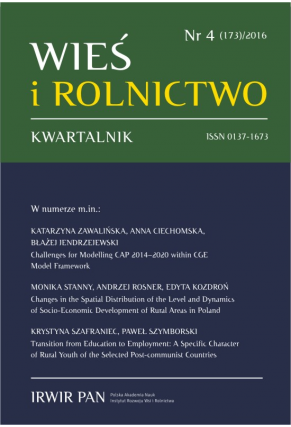Social Innovation Implementation by Rural Non-Governmental Organizations
DOI:
https://doi.org/10.53098/wir.2017.4.177/05Keywords:
social innovations, non-governmental organizations, rural areas, social problemsAbstract
The operation of local social policy entities inevitably involves looking for solutions to social problems. Measures aimed at solving social problems may be atypical, nonstandard, or alternative to what had previously been done in the locality. Social innovations understood this way are introduced by entities from different sectors. Each of them has its characteristics that may facilitate or hamper the process of implementation. The aim of the article is to answer the following questions: 1. What social problems are discerned by nongovernmental organizations operating in rural gminas of a province where social problems experienced by its residents are particularly numerous? 2. What kind of social problems do they try to reduce? 3. Do they introduce social innovations? If so, then 4. What kind of social innovations do they introduce? These questions are answered on the basis of results of empirical sociological research carried out in 2016 by applying a) the technique of unstructured interview with a standardized list of information to find, and b) the technique of in-depth unstructured interview on a sample of respectively 108 and 4 nongovernmental organizations from rural gminas of Lubelskie Province. These organizations divide social problems into problems which should be solved/reduced by public institutions, and problems which they can deal with by themselves. They very rarely try to solve problems that source literature identifies as crucial for the prevention of marginalization of rural areas (such as depopulation, poverty and unemployment). About 3% of the investigated organizations mostly introduce social innovations involving the provision of individualized services. Such innovations are usually short-term, which limits their potential for reducing social problems.
References
Alessio J. (2011). Social Problems and Inequality. Ashgate: Routledge.
Ayob N., Teasdale S., Fagan K. (2016). How social innovation ‘came to be’: Tracing the evolution of a contested concept. Journal of Social Policy, 45 (4), 635–653.
Bednarek-Szczepańska M. (2011). Organizacje pozarządowe na obszarach pozametropolitarnych na przykładzie wybranych regionów. Studia Obszarów Wiejskich, 26, 217–231.
Bock B. (2016). Rural Marginalisation and the role of social innovation; A turn towards nexogenous development and rural reconnection. Sociologia Ruralis, 56 (4), 552–573.
Bock B., Kovacs K., Shucksmith M. (2015). Changing social characteristics, patterns of inequality and exclusion. W: A.K. Copus, P. De Lima (red.). Territorial Cohesion in Rural Europe (s. 193–211). London–New York: Routledge.
Dart R. (2004). The legitimacy of social enterprise. Nonprofit Management and Leadership, 14 (4), 411–424.
Dyck B. van, Broeck P. van den (2013). Social innovation: A territorial process. W: F. Moulaert, D. MacCallum, A. Mehmood, A. Hamdouch (red.). The International Hand book on Social Innovation (s. 131–141). Cheltenham-Northampton MA: Edward Elgar.
Działek J. (2014). Is social capital useful for explaining economic development in Polish regions? Geografiska Annaler; Series B, Human Geography, 96 (2), 177–193.
Eikenberry A.M. (2009). Refusing the market: A democratic discourse for voluntary and non profit organizations. Nonprofit and Voluntary Sector Quarterly, 38 (4), 582–596.
Evers A., Ewert B. (2015). Social innovations for social cohesion. W: A. Nicholls, J. Simon, M. Gabriel (red.). New Frontiers in Social Innovation Research (s. 107–127). UK: Palgrave Macmillan.
Han J. (2017). Social marketisation and policy influence of third sector organisations: Evidence from the UK. Voluntas, 28, 1209–1225.
Jenson J., Harrison D. (2013). Social Innovation Research in the European Union. Approachces, Findings and Future Dirctions. Policy Review. Luxemburg: European Union.
Jessop B., Moulaert F., Hulgard L., Hamdouch A. (2014). Social innovation research: A new stage in innovation analysis? W: F. Moulaert, D. MacCallum, A. Mehmood,
A. Hamdouch (red.). The International Handbook on Social Innovation (s. 110–130). UK, USA: Edward Elgar.
Klein J.-L. (2014). Introduction: Social innovation at the crossroads between science, economy and society. W: F. Moulaert, D. MacCallum, A. Mehmood, A. Hamdouch (red.). The International Handbook on Social Innovation (s. 9–12). UK, USA: Edward Elgar.
Kołomycew A. (2014). Organizacje społeczne w strukturze partnerstw międzysektorowych w województwie podkarpackim. Profesjonalizacja i formalizacja jako konsekwencja zmian sektora społecznego. W: A. Kołomycew, B. Kotarba (red.). Partnerstwa w sferze publicznej (s. 137–151). Warszawa: Wydawnictwo Naukowe Scholar.
Montgomery T. (2016). Are social innovation paradigms incommensurable? Voluntas, 27, 1979–2000.
Moulaert F., MacCallum D., Mehmood A., Hamdouch A. (2014). General introdution: The return of social innovation as a scientific concept and a social practice. W: F. Moulaert, D. MacCallum, A. Mehmood, A. Hamdouch (red.). The International Handbook on Social Innovation (s. 1–8). UK, USA: Edward Elgar.
Mulgan G. (2006). The process of social innovation. Innovations: Technology, Governance, Globalization, 1 (2), 145–162.
Nicholls A., Simon J., Gabriel M. (2015). Introduction: Dimensions of social innovations. W: A. Nicholls, J. Simon, M. Gabriel (red.). New Frontiers in Social Innovation Research (s. 1–28). UK: Palgrave Macmillan.
Nickel P.M., Eikenberry A.M. (2009). A critique of the discourse of marketized philanthropy. American Behavioral Scientist, 52 (7), 974–989.
Oosterlynck S., Kazepov Y., Novy A., Cools P., Barberis E., Wukovitsch F., Sarius T., Leubolt B. (2013). The butterfly and the elephant: Local social innovation, the welfare state and new poverty dynamics. ImPRovE Discussion Paper No. 13/03. Herman Deleeck Centre for Social Policy. Antwerp: University of Antwerp.
Przybyłowska I. (1978). Wywiad swobodny ze standaryzowaną listą poszukiwanych informacji i możliwości jego zastosowania w badaniach socjologicznych. Przegląd Socjologiczny, 30, 54–68.
Rogers E.M. (1983). Diffusion of Innovations. Wyd. 3. USA: Macmillan Publishing.
Rymsza A. (2012). Zagubiona tożsamość. Analiza porównawcza sektora pozarządowego w Polsce i w Stanach Zjednoczonych. Warszawa: Ministerstwo Pracy i Polityki Społecznej.
Sorensen E., Torfing J. (2015). Enhancing public innovation through collaboration, leadership and new public governance. W: A. Nicholls, J. Simon, M. Gabriel (red.). New Frontiers in Social Innovation Research (s. 145–169). UK: Palgrave Macmillan.
Strategia Polityki Społecznej Województwa Lubelskiego na lata 2014–2020 (2013). Lublin: Regionalny Ośrodek Polityki Społecznej w Lublinie.
The Young Foundation (2012). Social Innovation Overview: A deliverable of the project: “The theoretical, empirical and policy foundations for building social innovation in Europe” (TEPSIE). European Commission – 7th Framework Programme, Brussels: European Commission, DG Research.
Zajda K., Sykała Ł., Janas K., Dej M. (2016). Metody i instrumenty rozwoju lokalnego. LEADER, RLKS, innowacje społeczne. Łódź: Wydawnictwo Uniwersytetu Łódzkiego.
Downloads
Article file downloads
Pages
How to Cite
Issue
Section
License
Copyright (c) 2017 Wieś i Rolnictwo

This work is licensed under a Creative Commons Attribution 4.0 International License.






